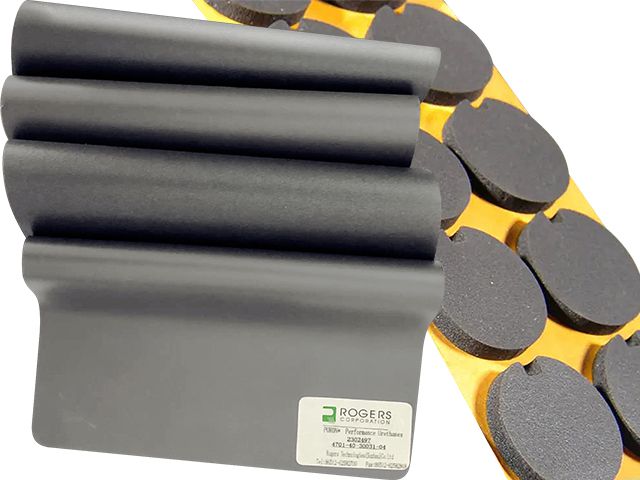Rogers Foam Die Cutting Precautions
Rogers foam is a high-performance foam material suitable for use in automobiles, electronics, refrigerators and air conditioners. It is also suitable for exterior coating, machining, and customization and stamping of related products. It can withstand high temperature of 150℃ and low temperature of minus 40℃. It also plays an irreplaceable role in the die-cutting of electronic accessories.
Rogers foam is ideal for applications where flexibility is particularly important. Foam materials maintain their integrity and effectiveness in caulking, gasketing and vibration isolation applications. It can meet the requirements of fixing and sealing of smooth parts of various parts, and is suitable for non-structural fixing and sealing of light and small materials, and has good waterproof performance.
In the production of Rogers foam die-cut parts, the following three challenges may often be encountered:
1. The arc is very easy to occur during the punching process of Rogers foam (the arc of the circular blade die cutting is very large);
2. This kind of thick foam plastic is very easy to cause slag and dust in the stamping die process;
3. For some porous structure products, it is difficult to discharge waste (the diameter is small, the thickness of the foam plastic is too thick, and the waste cannot be discharged);
We encountered the above three difficult problems in the process of Rogers foam die-cutting and came up with relative solutions; simple and detailed introduction: Rogers foam has high thickness, certain ductility and low ductility limit, which is very It is easy to cause smoke and dust. will be produced during the die cutting process.

arc puzzle
First, with regard to the chamfered edges that can easily occur during die cutting and stamping, the difficulty is due to the high thickness of the foam. During the stamping die process, the foam is extruded and laser cut after the foam plastic is extruded. Rounding corners, the key way to deal with this type of problem is to change the choice of special tools.
In this way, the special tool for shearing and pressing that we use is a double-inclined angle cutting tool for the actual operation of the punching machine. Therefore, in order to better ensure the reasonable reduction of the edge of the inclination angle, we use a flat knife to develop a stamping die for the inner and outer inclination angles, which can reasonably reduce the cause of the edge of the inclination angle of the foam.
In addition, in view of the relatively simple structure of Rogers foam die-cutting parts, we use the methods of longitudinal sectioning, edge trimming, and jump-cutting to reduce the factors that endanger the rounded corners, thereby preventing the rounding problem. For some products with a slightly complicated structure, we can use the method of dissolving the cutting line to open the hole, instead of turning off the cutting line and overlapping multiple sections, so as to reduce the extrusion molding stress during the opening process of the foam, thereby reducing the foam tilt. problem.
Dirty soot
Then there is the problem of Rogers foam flakes and soot, the direct cause of which depends on the characteristics of the foam itself. Because of the low ductility of foam, the composition structure is the foam raw material. All in the stamping die process, due to the repeated action of the knife, the slag foam particles are easy to generate dust and float in the air.
For some die-cutting jobs that must be cleaned up, there are many ways to deal with this dilemma. A common method is a sprayer release agent. The common method of production line is to compound OPP protective film on the surface of EVA foam to deal with this problem. Naturally, such methods are likely to result in the consumption of some auxiliary materials.
waste solution
Third, in terms of solving the waste with porous structure, the most fundamental reason is that the foam is too thick and the diameter is small, so that the waste cannot be extracted during the solution process. The general traditional method is to make a set of special tools for the mold thimble solution outside the mold base of the die-cutting machine, and to carry out cold stamping and milling according to the discharge of the skin pore waste from the mold thimble. However, this kind of waste treatment method is not very good, it is very easy to lift the foam, resulting in poor product quality. A common approach on round blades is a specialized tool for acquiring and tackling waste.
Workaround multi-threaded work
Fourth, the benefits of the multi-threaded work program process of the superior leadership; we all know that the top-level raw materials are driven by multi-threading, and the next-level raw materials are die-cut at the same time, so as to save raw materials. Here, we use a multi-thread method to separate the Rogers foam and the lining film to drive the raw materials, which not only saves the raw materials of the foam, but also consumes the foam frame during the operation. In addition, the arc is cleared, which will be greatly improved because of the effect of the working pressure. And, according to this kind of practical operation method, the basic soot problem has also been reasonably dealt with.
Only by selecting high-quality round blade die-cutting machines for production and manufacturing are not prone to the related problems.



